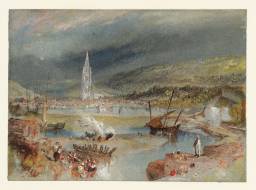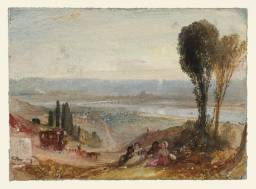‘Wanderings by the Seine’ Watercolours, for the ‘Turner’s Annual Tour’ Series (‘The Rivers of France’) c.1832–3

From the entry
This section comprises thirty-five watercolours of views on the river Seine in northern France. The watercolours were produced by Turner specifically in order to be made into engravings to illustrate two volumes, each entitled Turner’s Annual Tour – Wanderings by the Seine, published in 1834 and 1835 (the latter with the subtitle ‘from Rouen to the Source’). In total Turner produced forty designs which were engraved for the two publications. The additional five are Graville, c.1832 (currently untraced), Château de la Mailleraye, c.1832 (private collection), Rouen from St Catherine’s Hill, c.1832 (private collection), Paris: Boulevard des Italiens, c.1833 (private collection) and Confluence of the Seine and Marne at Charenton, c.1833 (private collection). With Turner’s Annual Tour – Wanderings by the Loire (1833), these three volumes formed the series later gathered into one as The Rivers of France ...
‘Wanderings by the Seine’ (1834) c.1832
D24667–D24676, D24693, D24695, D24696, D24698–D24701
Turner Bequest CCLIX 102–111, 128, 130, 131, 133–136
D24667–D24676, D24693, D24695, D24696, D24698–D24701
Turner Bequest CCLIX 102–111, 128, 130, 131, 133–136
‘Wanderings by the Seine, from Rouen to the Source’ (1835) c.1833
D24677–D24692, D24694, D24697, D40110–D40111, D40122–D40127
Turner Bequest CCLIX 112–127, 129, 132
D24677–D24692, D24694, D24697, D40110–D40111, D40122–D40127
Turner Bequest CCLIX 112–127, 129, 132
References
This section comprises thirty-five watercolours of views on the river Seine in northern France. The watercolours were produced by Turner specifically in order to be made into engravings to illustrate two volumes, each entitled Turner’s Annual Tour – Wanderings by the Seine, published in 1834 and 1835 (the latter with the subtitle ‘from Rouen to the Source’). In total Turner produced forty designs which were engraved for the two publications. The additional five are Graville, c.1832 (currently untraced),1 Château de la Mailleraye, c.1832 (private collection),2 Rouen from St Catherine’s Hill, c.1832 (private collection),3 Paris: Boulevard des Italiens, c.1833 (private collection)4 and Confluence of the Seine and Marne at Charenton, c.1833 (private collection).5 With Turner’s Annual Tour – Wanderings by the Loire (1833),6 these three volumes formed the series later gathered into one as The Rivers of France (1837), itself part of his larger project ‘Rivers of Europe’,7 which includes similar studies by Turner of other European rivers such as the Meuse and the Mosel(le), although these were never engraved.8 The volumes became referred to as Turner’s ‘Annual Tours’ as they were published in annual series; issued by Charles Heath as high-quality publications, they consisted of engraved plates after Turner with text by the writer Leitch Ritchie, and were very well-received.9
Turner based the watercolours on pencil sketches he had made on his travels through France undertaken to gather material for use in his work. The sketches range from various tours he made between 1821 and 1832, as discussed in this catalogue’s separate Introductions for the subsections of the watercolours from c.1832 and c.1833, for the 1834 and 1835 volumes respectively. Art historian A.J. Finberg previously identified that these watercolours were of Seine subjects and connected with the ‘French Rivers’ series. He had dated the watercolours to around 1830, further stating that he believed they ranged from about 1826 to about 1832 or 1833,10 but the date range has subsequently been narrowed to c.1832–3.11 Broadly, the locations covered stretch from towns on the Seine estuary, such as Harfleur, Le Havre and Honfleur, to the city of Rouen, through Paris, and further east to the town of Troyes.
All of the watercolours are made with gouache (opaque watercolour sometimes known as bodycolour, a paint consisting of pigments in a binding agent of water-soluble gum) on sheets of blue paper. Although Turner was already using gouache on mid-toned paper for informal colour sketches (for example, those of Petworth in 1827, mostly at Tate; Turner Bequest CCXLIV), these French rivers watercolours are the only such sketches he made as finished works for the engraver.12 In 1981 art historian Nicholas Alfrey pointed out that the use of gouache on blue paper helped clarify the progression of tones because the paper provided a mid-tone above or below which light or dark accents could be placed.13
In these watercolours Turner emphasised the effects of light, and contrasts of light and dark. Especially noticeable is his exuberant use of colour. Sometimes contrasting colours are deployed to convey the effects of light. As Victorian art critic John Ruskin put it, Turner ‘paints in colour but he thinks in light and shade’.14 Turner was well aware of the role engravings could play in popularising his work and was best known to the public of his day through engravings of his work.15 Yet for the engraver’s task of translating the works into tones of black and white, his colours could have been more of a hindrance than a help. In the 1820s Turner had become increasingly preoccupied with the relationship of colour to black and white. Most late eighteenth-century watercolours had been closely adapted to the needs of the engraver, with detailed underdrawing, beneath layers of grey wash to establish the distribution of light and shade. However, by Turner’s time this approach was being challenged. Turner’s later watercolours for engravers are expressive works of art in their own right, with fewer obvious concessions to the engravers’ needs.
These watercolours are some of the least detailed designs ever supplied by Turner to his engravers. They are particularly lacking in clear lines, and some elements are effectively indecipherable. Yet the resulting engravings are especially fine, detailed and sensitive. Turner achieved this by working closely with his engravers. Engraving is an artistic expression in its own right requiring skill and judgement, rather than merely copying, and over years Turner built up a group of engravers who were sympathetic to his work. He supervised the production of the works16 and was rigorous in his requirements, frequently annotating their proof impressions with instructions, comments, diagrams and touchings.17 As art historian Luke Herrmann suggests, this intense involvement had the further and broader result of Turner raising the standard of British engraving as a whole.18
See Wilton 1979, pp.409–12 nos.930–950, for the watercolour designs on blue paper, mostly in the Ashmolean Museum, Oxford.
Ian Warrell, ‘Seine’, in Joll, Butlin and Herrmann 2001, p.289; Wilton 1987, p.204;Wilton 2006, p.238.
How to cite
Caroline South, ‘‘Wanderings by the Seine’ Watercolours, for the ‘Turner’s Annual Tour’ Series (‘The Rivers of France’) c.1832–3’, November 2017, in David Blayney Brown (ed.), J.M.W. Turner: Sketchbooks, Drawings and Watercolours, Tate Research Publication, November 2019, https://www


